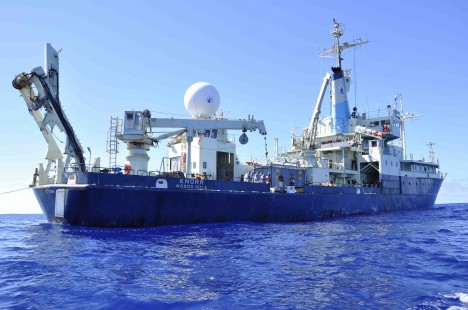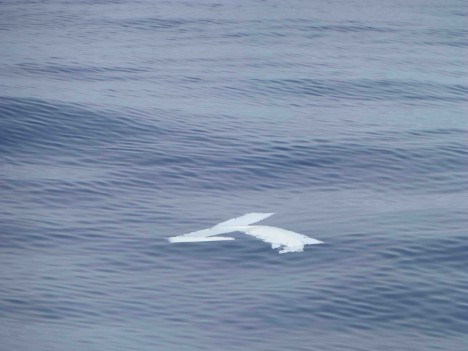By Eric Lindstrom
One of the things that we worry about on the ship, as part of our daily routine, is trash. Nothing goes over the side unless it is biodegradable. We have separate trash cans for plastics, foils, and other such material that would pollute the ocean. There are cans with paper liners for food scraps and paper waste. We keep the deck clean and our eyes open for any loose cable tie or anything else that could be washed overboard. It’s our duty to pick these things up and dispose of them properly.
It may be surprising to some of you how much plastic is already in the ocean. It’s both amazing and depressing. If one stands by the ship’s rail and watches the water go by, as one wants to do in an idle moment, it is quite shocking to realize that more man-made objects can be observed than natural ones (like fish). A 2005 report from the U.N. Environment Program estimated that, on average, more than 13,000 visible pieces of plastic litter were floating on any square kilometer of ocean.
Given the fact that plastic takes so long to break down, it should come as no surprise that this problem is still getting worse by the year, despite decades of effort to reduce the sources of pollution.
As a physical oceanographer, I know that the major ocean basins have gyre circulations at mid-latitude. The water moves in a great loop around the center of the ocean basins in the northern and southern hemispheres. Surface waters tend to converge toward the center of these gyres and trash of all sorts concentrates in these spots, far away from the coasts of the continents. In the North Pacific, there is the so-called “Great Garbage Patch” between California and Hawaii. Similar, but less well-known patches occupy dynamically similar regions in the other oceans. Nikolai Maximenko at University of Hawaii, a NASA-funded physical oceanographer studying the Pacific circulation, uses satellite and drifter data to understand this surface circulation in great detail. He made news with his analysis of the fate of tsunami debris from the 2011 Japan disaster.
Here in the Sargasso Sea, we have yet to see some giant patch of garbage (well, except for my desk in the upper lab!), but plastic does abound. I thought that I should testify as to my personal experience of observing so much plastic along our path. It’s more than I remember seeing 30 years ago, when I last sailed for an extended period in the Sargasso Sea. Its certainly not a scientific observation, but it reminds me that we are the creators and users of these materials and we should be the stewards of their disposal as well. So, pick up and recycle any loose plastic you see! It could wind up in the ocean.
Tags: Atlantic, Great Garbage Patch, NASA, oceanography, plastic, pollution, salinity, SPURS, SPURS1






I believe it is way past the time to start charging extra for ANYTHING that has plastic associated with it. Then with this money, pay to have the oceans cleaned up. Seems simple to me.
Peter,
Thanks for the comment. That is a question of social and economic policy outside my expertise.
There has been considerable progress in controlling the dumping of plastics from ships directly into the sea. (There is still the problem of accidents at sea where shipping containers are washed overboard in bad weather contributing their contents to the sea). However, it is thought that 80% of the plastics in the ocean are from land-based sources, not from any activity at sea. Therefore it is an important step for our stewardship of the ocean that those ashore “secure” their plastics, just like we do at sea.
Eric
In the garbage patch north of Hawaii, I’ve read that the plastic that has been broken up into small particles has even more mass than the stuff visible on the surface. Maybe someday it will be worthwhile to collect that small stuff concentrated by the gyre and recycle it.
By the way, a large floating dock has been spotted of Molokai island, the first of the Japanese tsunami debris to reach Hawaii.
Richard,
Thanks for the update on the Pacific.
There certainly is mounting evidence for the build-up of microscopic plastic bits in the ocean (e.g. http://news.nationalgeographic.com/news/2004/05/0506_040506_oceanplastic.html ). Given the vast expanse of ocean it is hard for me to imagine how it will ever be economically viable to collect the small pieces of plastic for recycling (even if one could do it without harming marine life). As they say, an ounce of prevention is worth a pound of cure!
Eric
Hi Eric,
Thanks for the nice article yet another reminder of the extent of problem we are globally facing. I am not sure what material you refer to as “biodegradable” here but if it is plastic then I would be a bit more apprehensive about its disposal in marine environment. This is fairly new to me too as I have come to learn more about the magnitude but also subtlety of the plastic problem only recently through my PhD studies and it appears that “While degradable polymers offer waste management solutions, there are limitations to their effectiveness in reducing hazards associated with plastic debris.” this is from a recent paper by Tim O’Brine, Richard C. Thompson (2010) titled: “Degradation of plastic carrier bags in the marine environment”.
Richard broken plastic or “microplastics” is indeed an emerging issue and is getting worse as there are many unknown about their fate in oceans but even if we knew where by collecting them you also remove planktonic lives a one off guess won’t be too bad but in large scale and too often perhaps not what would benefit the marine life in long term!
Dear Saeed,
Thanks for the info! Indeed, I am no expert and just a lay witness to the seas passing by as far as plastics go. I had read in a magazine that research was progressing on “biodegradable” and “photodegradable” plastics. Certainly, we have to worry about the chemistry of such “solutions” to the plastics problem in the environment. Trading permanence for toxicity in the ocean may be no bargain at all! From an oceanographer’s perspective more research on the fate and lifecycle of plastics in the ocean sounds quite reasonable.
Eric